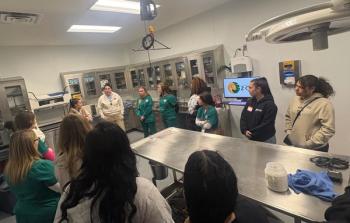
Regulations you need to know: Pharmacy (Part 1) (Proceedings)
The Board of Veterinary Medicine regulates and licenses people practicing veterinary medicine in the State. Although there are professional standards defining "veterinary-client-patient relationship" and proper prescribing of medications, it falls to the Board of Pharmacy in the state to regulate how prescription medications are dispensed to the general public.
Veterinarians and the State Board of Pharmacy
The Board of Veterinary Medicine regulates and licenses people practicing veterinary medicine in the State. Although there are professional standards defining
"veterinary-client-patient relationship" and proper prescribing of medications, it falls to the Board of Pharmacy in the state to regulate how prescription medications are dispensed to the general public. To simplify, the Board of Veterinary Medicine controls the professional PRESCRIBING of prescription medications and the Board of Pharmacy regulates the DISPENSING process for prescription medications. Veterinary practices must follow the regulations of both agencies.
Since veterinary practices are not licensed as retail pharmacies, it is normally against state pharmacy regulations to fill a prescription for a legend (prescription) drug that was written in (or phoned in from) outside the practice. In-house veterinary pharmacies are allowed to dispense prescription medication only to current patients of that practice when ordered by a veterinarian in that practice.
Dispensing Prescription Medications
Veterinarians may only dispense or administer a prescription drug (one that is labeled for use by or on the order of a veterinarian or physician) when he or she has a working knowledge of the conditions and treatment regimes of a particular patient and client. This is known as the veterinarian-client-patient relationship. This relationship is built on a simple foundation: the physical examination. Without the examination, the veterinarian-patient-client relationship does not exist.
In the food animal industry, it is customary to treat patients as groups in certain instances. The same relationship must still exist, but the examination can be of a herd or flock instead of a particular animal. Food animal veterinarians should be especially cautious of dispensing medications to clients who may not have a thorough understanding of the problem and the treatment protocol.
Clear directions including the drug name and quantity dispensed, dosage, route and frequency of administration must be written in the medical record or treatment sheet for all prescription drugs dispensed. The client should be especially cautioned (and it should appear on the prescription label) about the necessity for withholding milk or meat from treated animals in cases where residues of the drug may contaminate the product.
Packaging & Labeling
Prescription medications MUST be dispensed only in child-proof containers, even small quantity prescriptions such as a single tapeworm tablet, unless the client requests otherwise. Envelopes, baggies, or other similar containers can only be used to comply with the client's expressed verbal or written wishes for non-child-proof containers. The client may be asked if he or she would prefer an envelope or non-child-proof container BEFORE it is dispensed. When the client requests or approves of other dispensing containers, a note to that effect should be made on the medical record or treatment sheet. Although this is not mandated, medications that are pre-packaged for dispensing to clients, such as ophthalmic drops and ointments, fit nicely into a plastic pill vial. This practice gives the proper impression to the client (prescription medicine rather than an over-the-counter product) and provides an ideal place to adhere the prescription label.
Every container of prescription medication dispensed from a veterinary practice must comply with the labeling requirements of the Food and Drug Administration (FDA). At a minimum, the following information must be clearly printed or typed on a label affixed to the dispensing container:
• Identification of the hospital - including street address, city, state and phone number,
• Name of the prescribing veterinarian,
• The current date,
• The name of the patient - for veterinary prescriptions, the name of the animal and the last name of the owner are acceptable,
• The name, strength and quantity of the drug,
• Clear directions for use,
• Expiration date if the supply being dispensed will not be used up during the current treatment period (e.g., more than a month's supply),
• The number of authorized refills (optional, but printing NO REFILLS on the label is a good method to keep clients from calling back several months later and wanting "more of the stuff we had before"),
• Any special precautions (e.g., keep refrigerated, or shake well before use),
• The phrase "For veterinary use only" is recommended when the drug is one approved for use on animals only (Note: this phrase is routinely printed on all prescription labels from veterinary hospitals because it's easier than trying to decide which ones to label and which ones to omit).
• The phrase "Keep out of the reach of children" is also recommended and routinely used on all veterinary prescriptions.
Most labels are placed directly on the vial and clear tape is placed over the writing to prevent alterations or smudging. For the times when the directions are going to be lengthy (as in the initial steroid therapy) the label can contain all the regular information with a statement saying "See enclosed directions." The specific, detailed directions can then be rolled up and placed on the inside of the vial with the tablets. Directions such as "Give as directed" are very vague and should be avoided.
Compounding Medications
The FDA is greatly concerned about veterinarians and pharmacies that are engaged in manufacturing and distributing unapproved new animal drugs in a manner that is clearly outside the bounds of traditional pharmacy practice and that violates the Act (e.g., compounding that is intended to circumvent the drug approval process and provide for the mass marketing of products that have been produced with little or no quality control or manufacturing standards to ensure the purity, potency, and stability of the product).
"Compounding" does not include mixing, reconstituting, or other such acts that are performed in accordance with directions contained in approved labeling provided by the product's manufacturer and other manufacturer directions consistent with that labeling.
Generally, FDA will defer to state authorities regarding the day-to-day regulation of compounding by veterinarians and pharmacists of animal and human drugs that are intended for use in animals. FDA anticipates that, in such cases, cooperative efforts between the states and the Agency will result in coordinated investigations, referrals, and follow-up actions by the states.
Some activities that the FDA will consider outside of the parameters of legal compounding include:
1. Compounding of drugs that are prohibited for extralabel use in food-producing or nonfood-producing animals, under 21 CFR 530.41(a) and (b) respectively, because the drugs present a risk to the public health.
2. Compounding drugs for third parties who resell to individual patients, or offering compounded drug products at wholesale to other state licensed persons or commercial entities for resale. .
3. Compounding of drugs for use in animals where an approved new animal drug or approved new human drug used as labeled or in conformity with 21 CFR Part 530 will, in the available dosage form and concentration, appropriately treat the condition diagnosed.
4. Compounding from a human drug for use in food-producing animals if an approved animal drug can be used for the compounding.
5. Instances where illegal residues occur in meat, milk, eggs, honey, aquaculture, or other food-producing animal products, and such residues were caused by the use of a compounded drug.
EPA Product Dispensing
Germicidal preparations for use on inanimate objects, as well as rodenticides, and most insecticides are subject to the Federal Insecticide, Fungicide, and Rodenticide Act, administered by the Pesticide Regulation Division of the Environmental Protection Agency (EPA), Washington, D.C. 20460. However, some products used to control external pests are intended to act systemically and, therefore, are regulated as drugs by the FDA and not as pesticides by the EPA. For example, topically applied flea control products are usually regulated by EPA, whereas orally administered flea control products generally fall under FDA's jurisdiction. In those situations where violative residues of pesticides are detected in animal-derived human food products, FDA has the responsibility for regulatory enforcement.
EPA has issued a notice to remind retailers of a Dec. 31, 2004, stop-sale date for all outdoor diazinon home, lawn and garden products. It is now unlawful to sell diazinon outdoor non-agricultural use products in the United States. This is part of an agreement between EPA and diazinon registrants to phase out and eliminate all residential uses of the insecticide diazinon.
Off Label Drug Use
AMDUCA
The Animal Medicinal Drug Use Clarification Act of 1994 (AMDUCA) was passed by congress to alleviate some of the barriers veterinarians faced when they must prescribe human drugs for patients, and when they must use a drug that was not approved for a particular species of patient. Although these rules seem "common-sense" to many people, until now, veterinarians have been breaking the law every time they used a drug in either of these two ways. The Act has not changed the drug approval process, but has simply made it legal to prescribe a human drug (like insulin) for a veterinary patient. It has also made it acceptable to use a veterinary-specific drug on a species of animal for which it has not been approved by the FDA when no other veterinary drug for the same condition is available. It does not make it acceptable to use a non-approved drug in any species of animal for a condition when there is a drug licensed for that species.
From a regulatory standpoint, a companion animal veterinarian stands little risk of problems from extra-label drug use; however, many attorneys and practice consultants recommend obtaining an "informed consent" signature from the client. This does not mean the client waives his or her rights in any future actions against the practice, but it does prove that he/she was informed of the off-label use and granted their permission to proceed.
Food animal practitioners must be more conservative in their off-label use of medications. Since the FDA is seriously concerned with protecting the nation's food supply, there is definitely the chance of regulatory "scrutiny" if a drug residue was found in an animal at slaughter and was traced back to a veterinary practice. Specific guidance for the extra-label use of any medication in food animals should be obtained from the FDA's Center for Veterinary Medicine or the state veterinarian. Additionally, records should be maintained that clearly show the practice has informed the client of required milk and slaughter withholding times.
The following drugs are prohibited for extra-label animal and human drug uses in food-producing animals:
o Chloramphenicol
o Clenbuterol
o Diethylstilbestrol (DES)
o Dimetridazole
o Ipronidazole
o Other nitroimidazoles
o Furazolidone (except for approved topical use)
o Nitrofurazone (except for approved topical use)
o Sulfonamide drugs in lactating dairy cattle (except approved use of sulfadimethoxine, sulfabromomethazine, and sulfaethoxypyridazine).
o Fluoroquinolones
o Glycopeptides
Extra-label use of drugs in treating food-producing animals for improving rate of weight gain, feed efficiency, or other production purposes, or for routine disease prevention is prohibited under AMDUCA. A drug (including a bulk drug) may not be mixed into feed for any use or at a potency level not specifically permitted by the regulations in 21 CFR Part 558, even if prescribed by a veterinarian.
MUMSA
Minor use drugs are drugs for use in major species (cattle, horses, swine, chickens, turkeys, dogs, and cats) that are needed for diseases that have a limited geographic range or affect a small number of animals. Minor species are all animals other than the major species, which includes zoo animals , ornamental fish, parrots, ferrets, and guinea pigs. Some animals of agricultural importance are also minor species. These include sheep, goats, catfish, and honeybees.
The University of Florida CVM maintains an extensive database of drugs and dosages for minor species on the internet at
Internet Pharmacies
With the proliferation of internet pharmacies and chain stores getting into the veterinary pharmaceutical market, the veterinary practice may receive requests from clients for medications to be filled by these "outside pharmacies." If a medication would otherwise be prescribed for a patient, a veterinarian can not force a client to purchase needed medication from any specific source, including the in-house pharmacy. If the client requests a written or verbal prescription for medication, the veterinarian must provide that prescription if he/she would have otherwise dispensed the medication from the in-house pharmacy. This implies that a veterinary-patient-client relationship exists and that the veterinarian assumes the primary medical responsibility for the medical case.
It is certainly allowable for the practice to charge a reasonable fee for the execution of the prescription. Furthermore, attempting to educate the client on the hazards associated with internet drug purchases is certainly acceptable, including matching prices as a client courtesy. However, the prescription can not be withheld simply because the client chooses to have it filled somewhere other than the veterinary practice.
It is also acceptable for a veterinary practice to take refill orders from a client via the telephone, e-mail or other means of communication and ship the medication to the client's home or business as long as the refill would have been approved and dispensed if the client were present in the practice. If the medication to be refilled is a controlled substance, it must be shipped via a secure means with an adult signature obtained to confirm delivery.
There are many states Attorney's General that are trying to regulate the internet pharmacy industry, but that's a different issue...the practice can assist those law enforcement agencies but the veterinarian must still give a prescription to the client if he/she asks for it.
Newsletter
From exam room tips to practice management insights, get trusted veterinary news delivered straight to your inbox—subscribe to dvm360.






